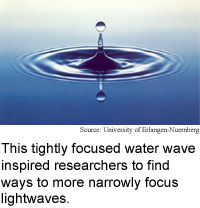
Spoke polarization tightens
focus
By
Kimberly Patch,
Technology Research NewsBeing able to focus precisely is an advantage in many settings.
Scientists have been able to make smaller transistors by finding ways to more closely focus the light beams that etch transistors into silicon wafers. Computer chips contain millions of transistors, and smaller transistors carry out computing faster simply because the electricity that switches them on and off has less distance to travel.
Conventional wisdom says that light can be focused only as narrowly as about half its wavelength before light rays start to reinforce and cancel each other in ways that make the point of light go fuzzy. Most research into producing narrower light beams has been aimed at using shorter-wavelength light.
Researchers from the University of Erlangen-Nürnberg have examined the conventional wisdom about light spots and found that is wrong. They demonstrated that it is possible to focus radially polarized light to an area around 40 percent smaller than the former theoretical limit.
The tighter focus can be used to etch smaller circuits in microchips, improve the resolution of microscopes, and cram more bits onto optical disks. The storage capacity of a DVD, for instance, could be increased by about 150 percent without changing the disk area or the wavelength of light used, according to Gerd Leuchs, a physics professor at the University of Erlangen-Nürnberg.
The tightly focused beams also contain an intense electromagnetic field at the point of focus that could be used to manipulate particles like atoms.
The researchers were inspired to look into the focusing potential of light because they had doubts about the limit, said Leuchs.
"In nature you can sometimes see strong enhancement if a wave comes into focus," Leuchs said. For instance, in the fraction of a second after a pebble hits the water and before waves radiate out from the spot, the disturbance is very tightly focused. (See picture.) The wave nature of electromagnetic energy is different, but the water observation triggered the notion to look into the electromagnetic wave focusing limit, he said.
The key to coming up with the method was recognizing that the polarization of light could be used to optimize focusing, said Leuchs. This has not been common knowledge partly because polarization has little importance in focusing with a slow lens, he said. A lens is slow if the lens diameter is smaller than its focal length. Slow lenses introduce only small changes in the direction of light rays passing through the lens close to the rim.
Light's electric field normally emanates in a plane perpendicular to the direction the light is traveling. Linearly polarized light has its electric field oriented in one direction on that plane. Polarizing sunglasses cut the sun's glare by blocking horizontally-polarized light.
Radially polarized light contains electric fields similar to the spokes of a wheel, and the light beam is more intense around the edges, with a hole in the middle, similar to a doughnut.
When the researchers focused the light through a ring-shaped opening, the electric field spokes rotated to become parallel, which caused them to interfere with and cancel each other out. The remaining components of the electric field were oriented along the beam's direction, which closed the doughnut hole and produced a smaller focal spot.
The challenges to carrying the method out were developing techniques to make radially polarized light, making a detector that spatially resolved electric field energy distribution irrespective of local polarization, and building a stable test setup that allowed the researchers to control the mechanical components, said Leuchs.
The researchers' next step is to study how radial polarization affects the interaction between light and matter, especially nanostructures.
Radially-focused light beams could be used practically in two years, said Leuchs.
Leuchs's research colleague were R. Dorn and S. Quabis. The work appeared in the December 2, 2003 issue of Physical Review Letters. The research was funded by the State of Bavaria, the Max Planck Society in Germany, the German National Science Foundation (Forschungsgemeinschaft), and the European Commission.
Timeline: 2 years
Funding: Government
TRN Categories: Optical Computing, Optoelectronics and Photonics
Story Type: News
Related Elements: Technical paper, "Polarization Optimized Focusing of Light and Coupling to Sub-Wavelength Antenna," December 2, 2003, Physical Review Letters
Advertisements:
April 21/28, 2004
Page One
Material grabs more sun
Spoke polarization tightens focus
Molecule makes electric motor
Optical quantum memory designed
Briefs:
Printer writes micro 3D objects
Tiny rotors spin into place
Nanotube forms drive shaft
Photons teleported six kilometers
Magnets align nanotubes in resin
Sturdy quantum crypto proposed

News:
Research News Roundup
Research Watch blog
Features:
View from the High Ground Q&A
How It Works
RSS Feeds:
News
Ad links:
Buy an ad link
| Advertisements:
|
 |
Ad links: Clear History
Buy an ad link
|
TRN
Newswire and Headline Feeds for Web sites
|
© Copyright Technology Research News, LLC 2000-2006. All rights reserved.